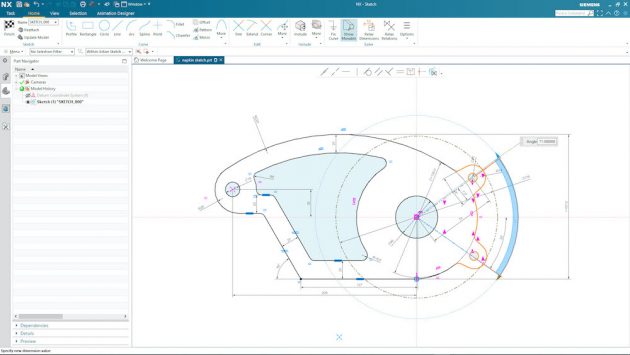
Siemens launches new solutions to ‘close the loop’ between PLM and cloud
June 23, 2020
By Kristina Urquhart
 Photo: Siemens
Photo: Siemens Siemens Digital Industries Software has unveiled several new updates to its portfolio for 2020, including a cloud-based project collaboration software and the realization of its previously announced partnership with IBM.
The company held a virtual version of its annual media and analyst conference last week, previewing several announcements under its Xcelerator umbrella ahead of the Siemens Realize Live customer event (Jun. 23 to 24).
The Xcelerator platform spans manufacturing, operations, simulation, IoT analytics, applications, collaboration, electrical and mechanical platforms using digital twins and a flexible ecosystem.
Siemens Digital Industries Software CEO Tony Hemmelgarn said COVID-19 could be “the ultimate catalyst that pushes humans to completely embrace digital transformation,” citing clients such as biotech company Moderna, which took 42 days to produce an experimental vaccine using a digital environment.
Another client, Vinfast – a Vietnam-based automotive manufacturer that Siemens helped to move from pre-construction to full-scale plant in the span of just 21 months – went from producing cars to ventilators in the span of three weeks. They now manufacture 55,000 ventilators a month.
“They were able to do this because of the agility of their digital enterprise,” Hemmelgarn said. He credited some of the platforms the company announced last year as the reason innovation was so rapid early in the coronavirus crisis.
Mendix expands
The crisis has solidified the need to fully dive in to digital transformation, said Brenda Discher, senior vice-president of marketing and strategy at Siemens Digital Industries Software. “It’s clear now more than ever that we must transform,” she said.
Discher highlighted the company’s expansion of the Mendix low-code application platform, which crossed the $100-million annual reoccurring revenue benchmark earlier this year. “Mendix is the core,” Discher said. “It can be used with any cloud on any platform, allowing us to deliver a tremendous amount of value to our customers.”
Siemens acquired Mendix in 2018, and took it from a cloud-based architecture primarily focused on business customers into one that caters to industry. It now features more than 100,000 available applications, and offers the capability for customers to produce custom apps, even if they have little application development knowledge.
Hemmelgarn said that while Mendix’s availability for industrial applications has been a draw for customers, the impact of COVID-19 on business has been partially responsible for a surge of interest in the platform. The company is seeing 144 per cent year-over-year growth in new bookings in 2020.
“The COVID crisis has really turned a lot of companies to wanting to build apps quickly,” he said. “Companies are saying look, as I work more remotely and digitally and so forth, how do I build apps quickly?”
The company revealed several other ways to enable rapid response for manufacturers. Here’s an overview of the major announcements:
Teamcenter heads to the cloud
Among the major announcements was Teamcenter X software, a new product lifecycle management (PLM) solution delivered through the cloud rather than on-premise.
Teamcenter X is a software-as-a-service (SaaS) offering, but it is not a replacement for the original on-premise Teamcenter platform – Siemens is adamant that it will maintain a variety of flexible solutions rather than force customers to move permanently to the cloud.
Teamcenter X creates a multi-domain bill of materials (BOM) to provide visibility to the complete digital twin (a virtual representation of a physical product or process) including mechanical, electrical and software components.
The suite uses an open multi-CAD approach and integrations to software tools, such as NX software and Solid Edge software for mechanical computer-aided design (CAD), Mentor software for electronic CAD and Polarion X software for Application Lifecycle Management (ALM).
Teamcenter X is built on Mendix, allowing the information contained within the software to be integrated to other parts of the business via the cloud.
The company also announced the late summer 2020 launch of Teamcenter Share, a cloud-based, design-centric project collaboration service designed for companies that want to move to an engineering-focused collaboration tool rather than using local or networked drives.
Teamcenter Share enables product development teams to synchronize desktop files to secure cloud storage, where they can view and mark up all common CAD formats from any device, and share project work with other stakeholders to facilitate collaboration on product development projects.
The platform also provides augmented reality (AR) capabilities that can be accessed from a tablet or smartphone to enable users to better understand how designs will function in the intended environment.
Finally, the new Teamcenter Assistant, an AI-based command prediction system similar in function to Apple’s Siri or Amazon’s Alexa, allows for voice commands in the Teamcenter platform.
AI-enabled CAD sketching
Siemens Digital Industries Software also released a new way to capture concepts in 2D while in a 3D CAD environment, with the NX Sketch tool for the company’s NX software.
Users are now able to sketch in CAD without pre-defining parameters, design intent and relationships. Using artificial intelligence (AI) to evaluate relationships on the fly, users can move away from a paper hand sketch and create concept designs within NX software.
This technology offers flexibility in concept design sketching, allowing rapid design iteration on legacy and imported data, and to work with tens of thousands of curves within a single sketch.
Often designers in concept-design stage do not necessarily know what the final product may be, which requires a sketching environment that is flexible and can evolve with the design.
Partnership with IBM
Siemens and IBM announced the general availability of their asset management and Service Lifecycle Management (SLM) solution, which connects real-world maintenance activities and asset performance back to design decisions and field modifications.
OEMs and owner/operators can struggle to improve the performance and reliability of an asset over its operating lifecycle, due to inefficient data sharing between engineering, operations and maintenance processes.
This joint SLM solution – which combines IBM’s Maximo Enterprise Asset Management software with product configuration management in Siemens Teamcenter – creates a single source of information designed to help OEMs and equipment owner/operators improve many aspects about how they design, maintain and service their assets.
The whole platform is linked to Siemens’ IoT solution, Mindsphere, which allows for information to be collected, processed, analyzed and visualized, to “close the loop” on product lifecycle information.
“There’s lots of talk about IoT, but can you really leverage it to the point where it’s making a difference in your business?” Hemmelgarn said. “You can do that with a closed loop.”
The SLM solution allows for OEMs to receive critical data about asset performance, maintenance and failures in the field.
Using the IoT technology in Mindsphere, manufacturers can gain insights on wear and tear, operating conditions, parts failures and other patterns that lead to design or manufacturing updates.
This data can be used to help manufacturers lower maintenance costs, reduce risks and improve asset resiliency.
Advertisement
- COVID-19 to leave some lasting economic damage, Bank of Canada chief says
- Trump says China trade deal still on after adviser’s remarks
